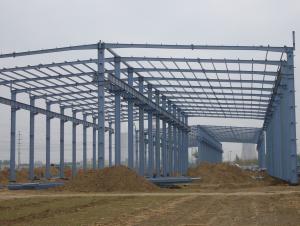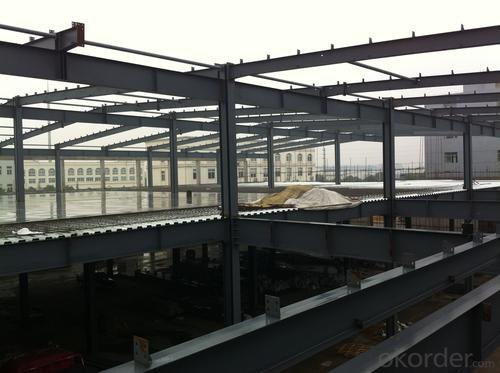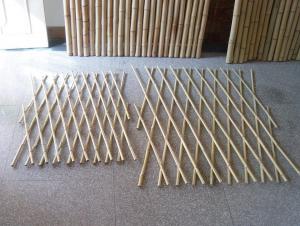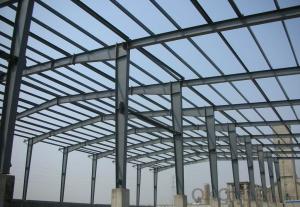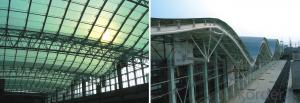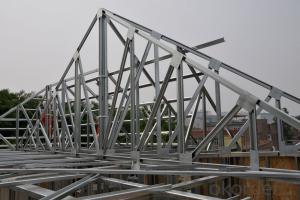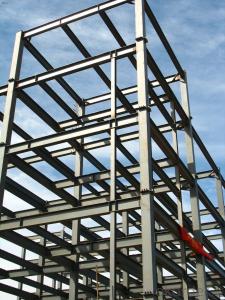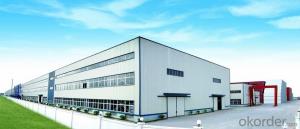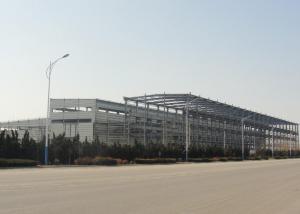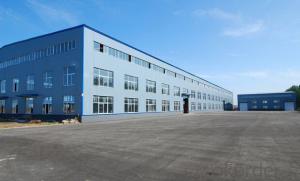Professional design of long span steel structure
- Loading Port:
- China Main Port
- Payment Terms:
- TT OR LC
- Min Order Qty:
- -
- Supply Capability:
- -
OKorder Service Pledge
OKorder Financial Service
You Might Also Like
Specifications
Specifications
1) . Easy to install, fire proof, good insulation
2). Certification: ISO9001:2000, SGS Standard.
Steel Structure Warehouse:
1.The steel structure of the connection method: welding connection
2.Steel structure design common norms are as follows: "Steel Design Code" (GB50017-2003) Cold-formed steel structure technical specifications" (GB50018-2002) "Construction Quality Acceptance of Steel" (GB50205-2001) "Technical Specification for welded steel structure" (JGJ81-2002, J218-2002) "Technical Specification for Steel Structures of Tall Buildings" (JGJ99-98)
3.The characteristics of steel Light weight steel structure Higher reliability of steel work Steel anti-vibration (earthquake), impact and good Steel structure for a higher degree of industrialization Steel can be assembled quickly and accurately Large steel interior space Likely to cause sealing structure Steel corrosive Poor fire-resistant steel Recyclable steel shorter duration
4.Commonly used steel grades and performance of steel Carbon
structural steel: Q195, Q215, Q235, Q255, Q275, etc.
High-strength low-alloy structural steel Quality carbon structural steel and alloy structural steel Special purpose steel Product Feature Carport, House, Office, Shop, Toilet, Villa, Warehouse, Workshop, Plant Other Information
Products have been all over the country more than 20 provinces, municipalities and autonomous regions, and have been exported to Europe, North America, the Middle East, Africa, Asia and other countries and regions, the widespread use
Welcome to our factory, we assure that our products will satisfy your needs with designs, competitive performance price ratio and best services.
- Q: What are the key considerations in the design of steel bridge structures?
- To ensure the safety, durability, and efficiency of steel bridge structures, engineers must take into account several crucial factors. Firstly, it is essential to carefully analyze the anticipated loads that the bridge will bear, including the weight of vehicles, pedestrians, and potential environmental factors such as wind or earthquakes. This analysis helps determine the appropriate size and strength of steel components, including beams, columns, and connections, to safely support the expected loads. Secondly, engineers must consider the overall structural integrity of the bridge. They need to ensure that the structure can withstand the forces and stresses it will experience during its design life. This involves factors such as the bridge's span length, the type of traffic it will accommodate, and the possibility of deformations or vibrations. By taking these factors into account, engineers can design a structure that is stable, rigid, and resilient. The choice of materials and fabrication techniques is another important consideration. Steel is commonly used in bridge construction due to its high strength, durability, and versatility. However, engineers must carefully select the appropriate grade of steel and consider factors such as corrosion protection, welding techniques, and fabrication methods to ensure the bridge's long-term performance and maintenance requirements. Moreover, the environmental impact is becoming an increasingly significant consideration in bridge design. Engineers must strive to minimize the ecological footprint of the bridge by considering the use of sustainable materials, energy-efficient construction methods, and the potential impact on local ecosystems and communities. Lastly, cost-effectiveness and constructability are key considerations. Engineers must balance the design requirements with the available budget and construction timeline. By considering factors such as construction methods, modularization, and the use of prefabricated components, engineers can optimize the design for efficient and cost-effective construction. In conclusion, the design of steel bridge structures involves considering factors such as load capacity, structural integrity, material selection, environmental impact, and cost-effectiveness. By carefully considering these factors, engineers can design bridges that are safe, durable, sustainable, and efficient.
- Q: What are the considerations for steel structure design in sustainable communities?
- There are several key considerations for steel structure design in sustainable communities. Firstly, the use of steel in construction offers significant environmental benefits, as it is a highly recyclable material with a long lifespan. This promotes sustainability by reducing waste and minimizing the need for new raw materials. In addition, steel structures can be designed to optimize energy efficiency, with features such as high-performance insulation and innovative ventilation systems. This helps reduce energy consumption and greenhouse gas emissions, contributing to the overall sustainability of the community. Furthermore, the design of steel structures should prioritize the use of locally sourced materials whenever possible. This reduces transportation impacts, supports local economies, and minimizes the carbon footprint associated with the construction process. Lastly, the adaptability and flexibility of steel structures allow for easy modifications or expansions in the future, reducing the need for new construction and promoting sustainable development practices. Overall, incorporating steel structure design in sustainable communities involves considering the material's recyclability, energy efficiency, local sourcing, and long-term adaptability to ensure a greener and more sustainable built environment.
- Q: What is meant by a steel structure? What's the explanation for the trouble?
- The term "limb" in a steel structure is most commonly used in latticed columns, in which the section, section, or plate is commonly referred to as the "limb". Like the limbs of a man, at the periphery.
- Q: How are steel structures designed to accommodate building services or utilities?
- Steel structures are designed to accommodate building services or utilities through the inclusion of various features such as service holes, utility trenches, and support systems. These features allow for the installation and integration of electrical, plumbing, HVAC, and other building services within the steel framework. Additionally, the design considers load-bearing capacities, accessibility, and maintenance requirements to ensure seamless integration and functionality of the building services within the steel structure.
- Q: What are the factors that affect the structural integrity of steel structures?
- There are several factors that can affect the structural integrity of steel structures. The first factor is the design and engineering of the structure itself. If the design is not properly executed or if there are flaws in the engineering calculations, it can compromise the overall strength and stability of the steel structure. Secondly, the quality of the steel used in the construction is crucial. The material should meet the required standards and specifications, and any defects or impurities in the steel can weaken the structure. Thirdly, external factors such as environmental conditions play a significant role. Exposure to corrosive elements like moisture, chemicals, or extreme temperatures can lead to corrosion and deterioration of the steel, reducing its strength over time. Additionally, the maintenance and upkeep of the structure are important factors. Regular inspections, repairs, and proper maintenance practices can help identify and address any issues before they escalate and affect the structural integrity. Lastly, human error during construction, such as poor welding, improper installation, or inadequate connections, can also impact the structural integrity of steel structures. Overall, a combination of design, material quality, environmental factors, maintenance, and construction practices determine the structural integrity of steel structures.
- Q: How are steel structures used in the construction of laboratories?
- Due to their numerous advantages and qualities, steel structures are widely utilized in laboratory construction. The primary reason is the strength and durability of steel, which makes it perfect for constructing laboratory buildings that must endure heavy loads and potential hazards. Steel structures provide the necessary support for specialized equipment, machinery, and large-scale experiments, ensuring the laboratory's safety and stability. In addition, steel has exceptional fire resistance, a critical consideration in laboratory construction. Given that laboratories often handle hazardous chemicals and materials, fire safety is of utmost importance. Steel structures possess a high melting point and do not ignite, thus providing reliable protection in case of a fire emergency. Furthermore, steel structures offer design and construction flexibility. Steel beams and columns can be easily fabricated and customized to meet specific laboratory requirements, optimizing space utilization and accommodating diverse research needs. The lightweight nature of steel also allows for quicker construction, minimizing project timelines and costs. Moreover, steel structures are renowned for their sustainability and environmental benefits. Steel is entirely recyclable, reducing waste and promoting a circular economy. By incorporating steel into laboratory construction, builders contribute to a greener and more sustainable construction industry. To summarize, steel structures play a crucial role in laboratory construction by providing strength, durability, fire resistance, design flexibility, and sustainability. These attributes make steel an ideal choice for creating secure, functional, and efficient laboratory spaces capable of withstanding the unique demands of scientific research and experimentation.
- Q: What are the common maintenance requirements for steel structures?
- The common maintenance requirements for steel structures include regular inspections for corrosion or damage, cleaning to remove dirt or debris, repainting or re-coating to prevent rust, and addressing any structural issues or repairs that may arise over time.
- Q: What are the design considerations for steel railway bridges?
- Some design considerations for steel railway bridges include the structural integrity and strength of the steel components to withstand the heavy loads and dynamic forces from passing trains. Additionally, the bridge must be designed to accommodate the specific track alignment, clearances, and vertical and horizontal curves of the railway. The bridge's foundation and substructure must also be carefully designed to provide stability and ensure long-term durability. Lastly, factors such as corrosion protection, maintenance access, and aesthetics are also important considerations in the design of steel railway bridges.
- Q: What are the considerations for designing steel structures for sustainable construction?
- When designing steel structures for sustainable construction, several considerations must be taken into account. Firstly, it is essential to ensure that the steel used is produced in an environmentally responsible manner, considering factors such as raw material sourcing, energy consumption, and emissions. Additionally, the design should aim to minimize the use of steel by optimizing the structural system and employing efficient construction techniques. Incorporating recycled steel can also contribute to sustainability goals. Furthermore, the overall life cycle of the structure should be considered, including its durability, potential for reuse or recycling, and the environmental impact of its eventual demolition. Lastly, the design should prioritize energy efficiency by incorporating insulation, efficient HVAC systems, and renewable energy sources to reduce the building's operational energy consumption.
- Q: How are steel structures designed for different recreational systems?
- Steel structures for different recreational systems are designed by considering various factors such as the intended use, load requirements, aesthetics, and safety regulations. The design process involves determining the appropriate size, shape, and configuration of the steel elements to ensure structural integrity and durability. Additionally, factors like environmental conditions, maintenance requirements, and budget constraints are also taken into account during the design phase. Overall, steel structures for recreational systems are carefully designed to provide a safe and enjoyable experience for users while meeting the specific needs of each recreational application.
Send your message to us
Professional design of long span steel structure
- Loading Port:
- China Main Port
- Payment Terms:
- TT OR LC
- Min Order Qty:
- -
- Supply Capability:
- -
OKorder Service Pledge
OKorder Financial Service
Similar products
Hot products
Hot Searches
Related keywords


